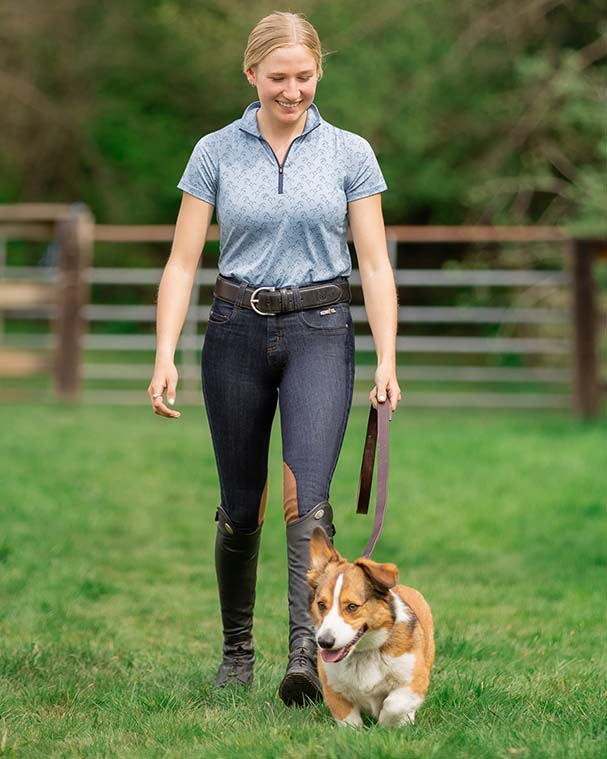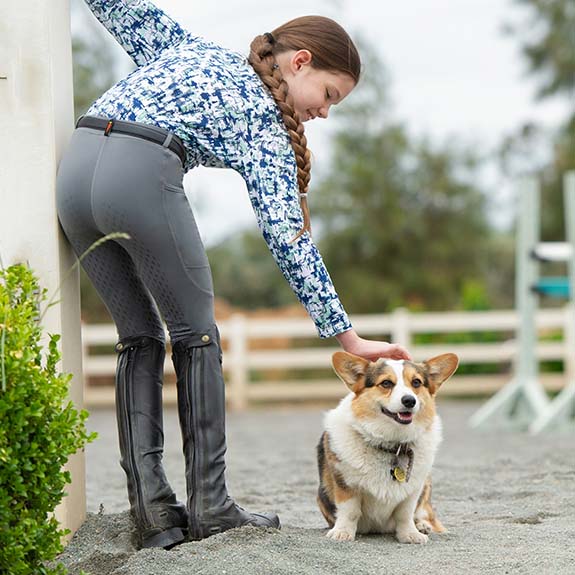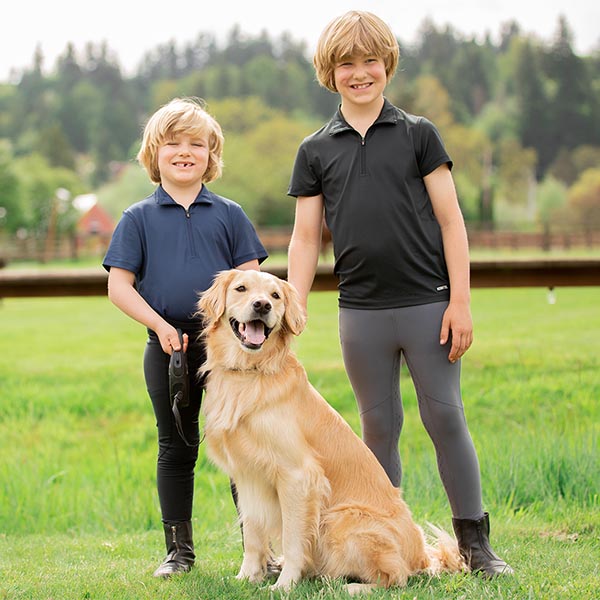
Stop by any barn and, chances are, you may see a farm dog or two happily greeting you at the door. With their wagging tails and friendly demeanor, their presence seems effortless and almost a part of the expected landscape. However, developing a well-behaved barn dog is anything but effortless, in fact, it requires patience, repetition, and a well-rounded approach to teaching your dog about horses, people, livestock, and other dogs.
We spoke with Amy Willey, the co-owner of the dog training and behavior business, Everything Dog, in Keene, NH, to learn more about training your dog to be well-behaved and respectful in a social barn environment. She has been working with people and training dogs using positive reinforcement-based methods for over 10 years, and her business provides services to clients in the Monadnock Region through private lessons, group classes, board and train, and day training services.
To learn more about what to do when bringing your dog to a barn and about the potential dangers that dogs encounter there, we encourage you to read our blog post, A Guide to Bringing Your Dog to the Barn.
Roles of a Barn Dog

Around the farm, a dog can have many different roles. From protection and vermin control to companionship and acting as a warning alarm, barn dogs help make sure that the farmyard is running smoothly. On some ranches, working dogs are used to move cattle and sheep, while other farms utilize dogs to protect their herd overnight.
At most New England horse farms, dogs serve as constant companions to their owners, staying safely nearby during riding and chore times. Additionally, barn dogs help to reassure the farmworkers, especially if they are doing tasks alone in the barn during the early morning or late evening hours. They alert their owner if something has gone awry, keeping an eye on the property. So a barn dog can help to keep the people in the barn safe, while also deterring predatory animals from hanging around the property. Whether you live on-site or bring your dog with you daily, they have a valuable role around the farm.
Selecting a Barn Dog
Barn dogs come in all shapes and sizes, but they have many similarities. Generally, a barn dog needs to be well-behaved and possess excellent recall skills. They need to be comfortable around horses and other farm animals while understanding that they should not chase, bite, or bark at them. Similarly, the dogs should be pleasant and agreeable around other people that may visit the barn. Many barn owners let their dogs roam the farm, while others keep them tied or utilize an electric fence system. All of these are appropriate options depending on the individual dog.
When looking for a barn dog, it is important to be aware of their temperament and personality. A laid-back dog will be able to adjust to the environment much more easily than a nervous or anxious dog. Additionally, it will be easier to have an independent dog around the barn, than one is constantly looking for human interaction. It can be difficult to provide the dog with reassurance while you are grooming, cleaning stalls, riding, etc.
Generally, any breed of dog can be a great barn dog, it largely depends on their individual temperament and upbringing. However, some breeds are more popular than others. Some common breeds of dogs that you will see on farms include:

- Australian Shepherd
- Jack Russell Terrier
- Labrador Retriever
- Golden Retriever
- Australian Cattle Dog
- Border Collie
- German Shepherd
- Pembroke Welsh Corgi
- Great Pyrenees
- American Foxhound
- Smooth or Rough Collie
Mixed breeds also make wonderful well-rounded barn dogs! Talk to your local rescue about what you are looking for, many rescues are familiar with their dog’s temperaments and can help to guide you in the right direction about which dog may be the most suitable for adoption.
Once you have selected your dog, it is time to bring them to the vet! All dogs should be fully vaccinated and up to date on tick, flea, and heartworm control before ever stepping foot in the barnyard.
Start Early (and Slowly)
Once you have decided to bring your dog to the barn, it is important to think about how you will introduce the new environment to them. It’s best to start any training or expectations as soon as you get your puppy or dog,” Amy explains. This gives your dog a baseline understanding of what you are asking of them. The earlier it begins, the easier it will be to establish the wanted behaviors.

“The socialization window for puppies is from about 3-16 weeks; after that, everything we really do is conditioning — it is a subtle difference, but it’s different,” Amy tells us. Proper socialization of a young puppy is about exposure to anything (and everything that you would like the puppy to be comfortable with as they mature. Just hanging out in different contexts (barn area, farm, parks, parking lots, friend’s yard) where the puppy can watch the world go by while you help create positive associations by petting them, talking to them, and feeding them is a great start.
Contrary to what many people believe, a puppy does not need to meet and greet large numbers of people and dogs to be socialized — they just need to get out in the world and see and observe a wide variety of people, dogs, farm animals, etc. in different contexts to feel comfortable with seeing these things in the future.
“The important thing about socialization is that it must be done within the comfort level of the puppy,” Amy continues. “If we put young puppies in situations that frighten them or make them shut down in an effort to socialize them, we are really taking a risk that we are making the puppy feel more afraid of these things.”
“For young puppies, careful socialization is essential — puppies who have a bad experience or get overwhelmed by another dog (even once) can become reactive,” she continues. “So socialization should be slow and careful with other puppies/dogs who match your puppy’s personality and play style.”

Starting further away from the new object/animal/person when conditioning a dog and moving closer as your dog says he is ready is much better than starting too close and creating a problem that you have to fix later. This is especially important with horses and other livestock because they are so much larger than your dog — be sure to start at a distance where your puppy/dog can see the horses/animals but not become frightened or “barky” about them. Keep conditioning sessions short and fun for your dog — 5-10 minutes is plenty of time to start with. In general, If possible, more frequent, shorter sessions are better for conditioning.
In all situations, whether you are introducing your dog to dogs, horses, or people, it’s also important to recognize and respect your puppy or dog’s personality. Just like people, some are introverts and some are extroverts. “Forcing your introverted puppy or dog to interact with a stimulus when they don’t want to or feel too nervous about the situation can create bigger issues in the long-term like reactivity,” Amy explains.
Reliable Obedience
In order to be safe and promote safety for the humans and animals around them, there are a number of commands that your dog needs to obey. Make sure that you can rely on your dog to listen to these commands prior to bringing them to the barn with you and interacting with the animals there.
Stay
This command indicates to your dog that they should remain in one set location. “Stay” can be used in a number of ways, but is it especially important when you are leading a horse, grooming a horse, or working with a horse that you need your dog to keep their distance.
Come
An excellent recall is a necessary skill for the barn dog. You should be able to use this command and have your dog respond whenever they are in earshot. Around the farm, you may use this in emergency situations, additionally, you may use it if you see your dog venturing somewhere that is potentially dangerous to them, such as the road or a pasture.
Down
Whenever you redirect your dog, it can be helpful to give them something to do instead as an alternative behavior. Teaching “down” to your dog as a command to lie and stay, gives them something to focus on and encourages wanted behaviors.
Drop It/Leave It
Your dog will encounter many potentially toxic substances around the farm. Teaching and utilizing these commands will help you ensure that your dog is not ingesting these poisonous substances. Additionally, it is extremely helpful if your dog grabs something like a leg wrap or a piece of tack and thinks that is a toy.
Go/Out
These commands tell your dog to leave the location immediately. This may be a barn-specific command, but is it exceedingly important that your dog responds instantly. “Go” or “Out” can be used to tell your dog to leave a stall, the barn, or the arena in the event of an emergency.

These skill sets are so important, that the American Kennel Club (AKC) has actually put together a Farm Dog Certification program to test dogs to ensure that they can perform tasks that are typically seen in a barn environment. In order to be eligible for AKC Farm Dog Certification, the dogs showcase their confidence and attention to their handle in a variety of situations, being in the close proximity to livestock, walking on varied terrain, long stays in designated locations (such as the tops of hay bales), and allowing for physical examination, such as inspecting footpads and under the tail, after a day in the barn. While this certification may not be important to you or your dog, it is a good benchmark for skills that your dog will need to perform on a daily basis.
Social Interactions
If there is more than one dog on the farm, you will need to be aware of how this may affect your dog’s behavior. Sometimes, if there is a group of dogs, they may act differently than they would if they were alone. In many cases, one dominant dog may get the other dogs in trouble, bringing them on adventures all over the property in a pack mentality. Make sure that you keep a close eye on the dynamics of their social interactions and make adjustments as needed. You may find that your need to keep a certain dog tied or outfit a dog in an electric fence collar to keep the dogs safely contained on the property.
Put Your Dog First
While many dogs enjoy being barn dogs and are able to acclimate well, not every dog is cut out to be a barn dog. It is important to pay attention to your dog and their individual needs to determine if this is an appropriate setting for them. “Every dog is a being with emotions, genetics, and life experiences that matter and influence who they are,” Amy explains. “We have to consider that while some dogs are highly adaptable, not every dog can adapt to every situation.”

A genetically fearful dog will likely be fearful in spite of the best socialization efforts and a genetically solid dog will likely be solid in spite of a lack of socialization. “While socialization and training can help, they can not undo genetics,” Amy continues. “In short, there are things about our dog’s personalities that we can control and there are some things we can’t. Puppies are not blank slates — they are much more complicated than that.” As dog owners, we do our best to control the pieces of the puzzle that we can with socialization and training, but we need to understand and accept our dogs for the complex beings that they are. You may discover that your dog only enjoys being at the barn during certain times of the day (during stall cleaning, however, but not when you are riding) and you can make accommodations for their needs.
The Reward
A well-behaved barn dog is more than a wonderful friend, they also have a myriad of other duties around the farm. With a bit of patience and a commitment to training, you can have a barn mascot that provides protection, companionship, and vermin control. A great barn dog truly is one of the most valuable additions to any farm.
We would love to hear about the special barn dog in your life! Tell us about them in the comments below.
